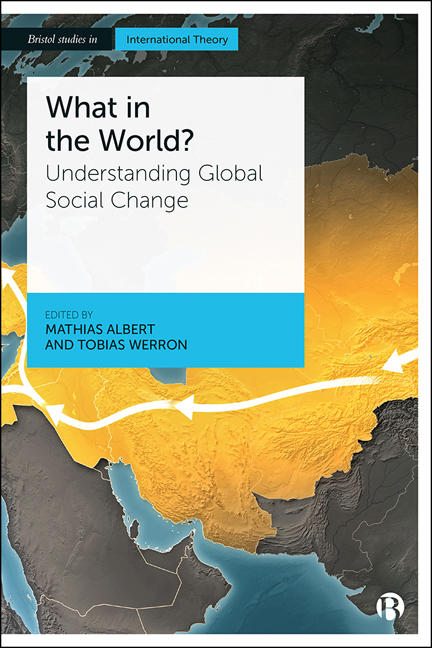Book contents
- Frontmatter
- Contents
- List of Figures and Tables
- Notes on Contributors
- Acknowledgements
- 1 Introduction: World Society and Its Histories – The Sociology and Global History of Global Social Change
- 2 Every Epoch, Time Frame or Date that Is Solid Melts into Air. Does It? The Entanglements of Global History and World Society
- 3 Periodization in Global History: The Productive Power of Comparing
- 4 Communication, Differentiation and the Evolution of World Society
- 5 Field Theory and Global Transformations in the Long Twentieth Century
- 6 Organization(s) of the World
- 7 Particularly Universal Encounters: Ethnographic Explorations into a Laboratory of World Society
- 8 From the First Sino-Roman War (That Never Happened) to Modern International-cum-Imperial Relations: Observing International Politics from an Evolution Theory Perspective
- 9 Nationalism as a Global Institution: A Historical-Sociological View
- 10 States and Markets: A Global Historical Sociology of Capitalist Governance
- 11 The Impact of Communications in Global History
- 12 The ‘Long Twentieth Century’ and the Making of World Trade Law
- 13 Third-Party Actors, Transparency and Global Military Affairs
- 14 Technical Internationalism and Global Social Change: A Critical Look at the Historiography of the United Nations
- References
- Index
6 - Organization(s) of the World
Published online by Cambridge University Press: 22 December 2021
- Frontmatter
- Contents
- List of Figures and Tables
- Notes on Contributors
- Acknowledgements
- 1 Introduction: World Society and Its Histories – The Sociology and Global History of Global Social Change
- 2 Every Epoch, Time Frame or Date that Is Solid Melts into Air. Does It? The Entanglements of Global History and World Society
- 3 Periodization in Global History: The Productive Power of Comparing
- 4 Communication, Differentiation and the Evolution of World Society
- 5 Field Theory and Global Transformations in the Long Twentieth Century
- 6 Organization(s) of the World
- 7 Particularly Universal Encounters: Ethnographic Explorations into a Laboratory of World Society
- 8 From the First Sino-Roman War (That Never Happened) to Modern International-cum-Imperial Relations: Observing International Politics from an Evolution Theory Perspective
- 9 Nationalism as a Global Institution: A Historical-Sociological View
- 10 States and Markets: A Global Historical Sociology of Capitalist Governance
- 11 The Impact of Communications in Global History
- 12 The ‘Long Twentieth Century’ and the Making of World Trade Law
- 13 Third-Party Actors, Transparency and Global Military Affairs
- 14 Technical Internationalism and Global Social Change: A Critical Look at the Historiography of the United Nations
- References
- Index
Summary
Introduction
In his classical text on international organization, Swords to Ploughshares, Inis Claude (1959: 43) stated:
It is useful to consider the nineteenth century as the era of preparation for international organization, and, for this purpose, to treat 1815, the year of the Congress of Vienna, and 1914, the year of the outbreak of World War I, as its chronological boundaries. Starting thus, we establish the years which have passed since the momentous events of 1914 as the era of establishment of international organization, which, in these terms, comes to be regarded as a phenomenon of the twentieth century.
According to this quote, the nineteenth century was a period of war and anarchy among states and state-like entities that led to World War I. It was a period of preparation because the idea of international organization was not yet born, but rather emerged from the destructive consequences of that war. In this narrative, the foundation of the League of Nations is the starting point for the period in which the idea of organizing the international sphere was born and international organizations were established. In the second half of the twentieth century, and in particular after the end of the Cold War, international organizations emerged as ‘pieces of global governance’ (Karns and Mingst, 2010: 5–8) that were active in almost all policy fields. In organizing these policy fields, international organizations took over more and more extensive duties and responsibilities for their member states. However, their function was not limited to facilitating cooperation between member states. Quite the contrary; international organizations provided an action frame that served as a reference point for both states and non-state organizations.
Even though this is a very short and simplified description of the history of international organization(s), it is nevertheless widely shared by scholars in International Relations (IR). They see the twentieth century as the period of international organization and the foundation of international institutions of various kinds, most notably international organizations, that are evolving as actors in world politics in the twenty-first century.
This chapter takes a closer look at the emergence of the idea of international organization. It reflects on the actual concept of organization, which saw the light of day in the nineteenth century, and regards organization and the founding of (international) organizations as key features of global social change (see Albert and Werron, Chapter 1 in this volume).
- Type
- Chapter
- Information
- What in the World?Understanding Global Social Change, pp. 99 - 116Publisher: Bristol University PressPrint publication year: 2020



